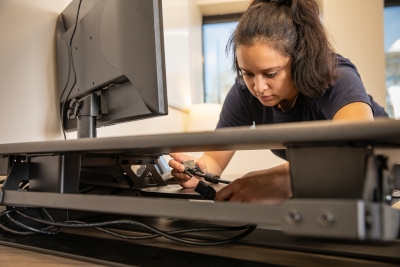Moving your computer systems to a new location could raise any or all of these questions. You need solutions to protect your computer network so that your company avoids unnecessary downtime after an office move. Here are some steps you can take:
1. Plan your technology move early
Relocating IT systems requires strategic planning. Start by assessing the new office’s network infrastructure. Your IT team should:
- Evaluate network cabling, server racks, and internet connectivity at the new location.
- Coordinate with your internet service provider (ISP) at least two months before the move to ensure high-speed internet setup on time.
- Identify any hardware upgrades needed to optimize performance in the new space.
2. Assess and upgrade computer network equipment
An office relocation is a great opportunity to evaluate your current computer equipment. Before relocating:
- Inspect existing servers, workstations, and network devices to determine if upgrades are necessary.
- If replacing outdated equipment, work with your IT relocation specialists to properly dispose of old electronics through eco-friendly recycling programs.
3. Back up your business data
Make it a priority to create several full-recovery backup copies of your company’s data systems, firewalls, and servers before the move. While professional office moving companies do all they can to ensure the safety of your systems, something could go wrong during the move. Transport these backups separately from the main system. If something happens to the main system, the backups are still safe and accessible.
4. Hire professional office movers specializing in IT relocation
 While DIY moving might work for a residential move, when it comes to relocating your office, hiring trained and certified office moving professionals is a must to ensure that your computer network is handled and set up with the utmost care and attention to detail.
While DIY moving might work for a residential move, when it comes to relocating your office, hiring trained and certified office moving professionals is a must to ensure that your computer network is handled and set up with the utmost care and attention to detail.
At JK Moving Services, our certified PC Technicians handle:
- Computer and server relocation, including disconnect and reconnect services.
- Secure packing using our comp-u-wrap system to protect sensitive IT equipment.
- Custom crating for specialized office technology and data center moves.
5. Test your network after setup
Your office relocation is not finished when the movers set up the computer screens and keyboards. There are several items to check on after the initial installation. First, ensure all the equipment is in the right place. Then start all your network servers, test your computer systems, and check data migration. Finally, confirm that incoming and outgoing emails, intranet and extranet, and all your network connections work.
Minimize downtime with a smart IT relocation strategy
By following these steps, your computer network move can be smooth and secure, preventing downtime and maintaining business continuity. Working with professional IT movers ensures your equipment is transported safely and set up efficiently in your new office.
Need expert help with computer network relocation? Contact JK Moving Services for a seamless, stress-free move!


